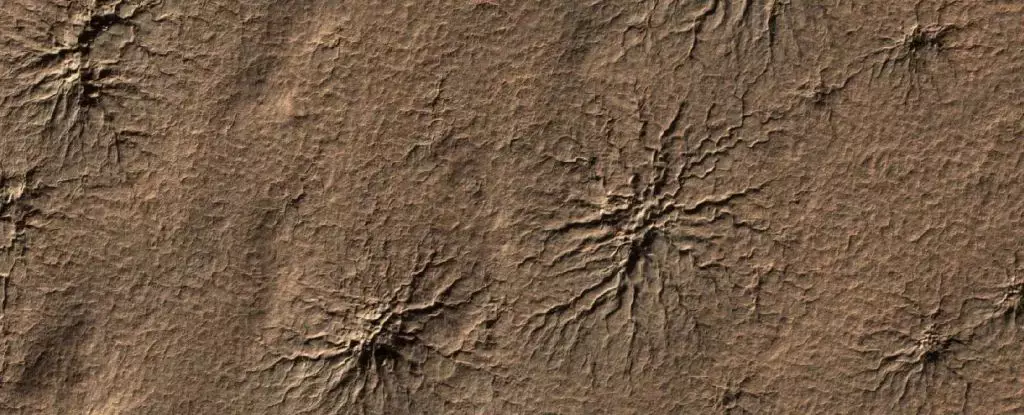Mars has long fascinated scientists and enthusiasts alike with its otherworldly landscapes, and one of its most enigmatic phenomena is what scientists have dubbed “araneiforms,” or Martian “spiders.” These intriguing formations, which appear as long-legged shadows across the planet’s surface, are not actual spiders but rather unique geological features arising in the southern polar region during the Martian spring. Recent laboratory experiments have shed light on how these formations occur, presenting a fascinating glimpse into the processes that shape the Martian terrain and answering long-standing questions about their origins.
The appearance of araneiforms is a delightful yet perplexing spectacle. Satellite images reveal dark, tendril-like structures that often evoke the image of spiders scurrying across the ochre dunes and impact craters of Mars. However, these structures are composed of dust and are a result of complex geological processes influenced by the extreme conditions present on the Martian surface. Unlike Earth, where conditions permit carbon dioxide to exist in both liquid and solid forms under controlled circumstances, Mars experiences deep cold that causes carbon dioxide to freeze directly into solid ice. This fundamental difference plays a crucial role in the formation of araneiforms.
The prevailing model of how araneiforms form is known as the Kieffer model, named after geophysicist Hugh Kieffer, who meticulously studied Martian seasonal features in the mid-2000s. According to this model, during the frigid winter months, atmospheric carbon dioxide freezes onto the Martian surface, creating layers of ice. When spring arrives and temperatures start to rise, this ice sublimates back into gas. This process occurs from beneath the surface of the ice slabs, where darker, thermally superior Martian soil absorbs heat. As gas accumulates and pressure rises beneath the icy surface, it eventually leads to small explosions that create cracks through which carbon dioxide and dust are expelled, forming scars that resemble spider legs.
The challenge of understanding araneiforms has led researchers to create experimental setups that simulate Martian conditions. A team of scientists, under the leadership of planetary scientist Lauren McKeown from NASA’s Jet Propulsion Laboratory, utilized a specialized chamber known as the Dirty Under-vacuum Simulation Testbed for Icy Environments (DUSTIE) to recreate the environmental conditions of Mars. By mimicking both the temperature and atmospheric pressure found on the Red Planet, the researchers aimed to explore the processes that govern the formation of araneiforms in a lab setting.
The experiment began with the preparation of a simulant designed to mimic Martian regolith—essentially the dirt of Mars. The team cooled this mixture using liquid nitrogen, then placed it in the DUSTIE chamber, allowing carbon dioxide to freeze onto the simulant surface. As they meticulously adjusted temperature and pressure levels, the scientists awaited the moment when the accumulated pressure would lead to the expected explosive release of gas.
In a thrilling turn of events, the conditions within the chamber resulted in the successful replication of araneiform structures, producing formations strikingly similar to those observed on the Martian surface. However, the scientists were surprised to discover that the ice was not forming above the dirt as initially theorized; rather, it formed beneath it. This insight revised their understanding of the processes at play, indicating that the pressure build-up and resultant formations were due to gas escaping from within the soil, rather than from above.
The findings from McKeown’s team have significant implications, not only for our understanding of araneiforms but also for the broader suite of seasonal geological features on Mars. By confirming and refining the Kieffer model, these experiments illustrate the dramatic and complex interplay between Martian frost, sublimation, and geological activity.
Future research endeavors will likely focus on further manipulating the conditions within the DUSTIE chamber to explore how various environmental variables influence the formation of other Martian surface features. There is much work to be done in fine-tuning the experiment, with scientists eager to uncover even more about the geological processes that may, against all odds, hold clues to the planet’s potential for past life.
As we continue to probe the mysteries of Mars through innovative experimentation and exploration, one can only hope that we do not find ourselves at the mercy of the “spiders” arising at NASA headquarters! The thrilling pursuit of knowledge about the Martian environment undoubtedly opens new frontiers in our understanding of the solar system and our place within it.


Leave a Reply